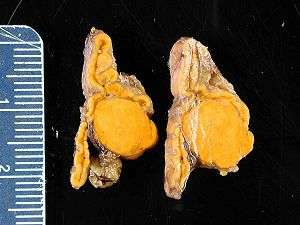Adrenocortical adenoma
| Adrenocortical adenoma | |
|---|---|
 | |
| Adrenal adenoma in a patient with Conn syndrome | |
| Specialty |
Endocrinology, Oncology |
A adrenocortical adenoma (or adrenal cortical adenoma, or sometimes simply adrenal adenoma) is a benign tumor of the adrenal cortex.
It can present with Cushing's syndrome or primary aldosteronism.[1] They may also secrete androgens, causing hyperandrogenism. Also, they are often diagnosed incidentally as incidentalomas.
Is a well circumscribed, yellow tumour in the adrenal cortex, which is usually 2–5 cm in diameter. The color of the tumour, as with adrenal cortex as a whole, is due to the stored lipid (mainly cholesterol), from which the cortical hormones are synthesized. These tumors are frequent incidental findings at post mortem examination, and appear to have produced no significant metabolic disorder; only a very small percentage lead to Cushing's syndrome. Nevertheless, these apparently non-functioning adenomas are most often encountered in elder obese people. There is some debate that they may really represent nodules in diffuse nodular cortical hyperplasia. Very occasionally, a true adrenal cortical adenoma is associated with the clinical manifestations of Conn's syndrome, and can be shown to be excreting mineralocorticoids.
Histopathology images
See also
References
External links
| Classification | |
|---|---|
| External resources |
_adrenocortical_adenoma.jpg)
_adrenocortical_adenoma.jpg)
_adrenocortical_adenoma.jpg)